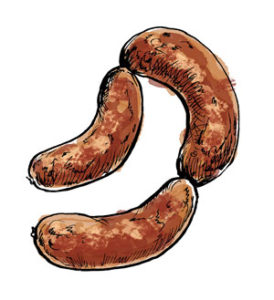Which of these American smoked-meat traditions fares best?
Comparing Texas barbecue to that of Kansas City is a bit of an apples-and-oranges juxtaposition. But contrasting smoked meat from the second-largest state in the country to that of a single midsized city isn’t as off base as one might think.

Texas has four main regional styles, says Texas Monthly barbecue editor Daniel Vaughn: East Texas, West Texas, South Texas/Rio Grande Valley, and Central Texas. For all their differences, “nearly every barbecue joint in Texas serves the Texas Trinity,” Vaughn says. “That’s brisket, pork ribs, and smoked sausage. The sausage is one of those things you don’t find in a lot of other barbecue traditions, but it comes from our meat market days, and we’re seeing a resurgence in the house-made varieties.” Historically, German American-owned smokehouses influenced Central Texas-style ’cue. It focuses on brisket, imparting it with heavy post oak smoke flavor, and saucing the thick slices is left to the customers if sauce is offered at all. Texas’ Mexican heritage is evident in the Rio Grande Valley’s barbacoa-style beef head buried with hot coals. West Texas barbecue tends to be “cowboy-style,” cooked directly over mesquite fire, while African American-influenced East Texas stands traditionally offer more pork options, plus hot links, boudin, and chopped brisket sandwiches.
Kansas City’s barbecue is similarly wide-ranging, despite the municipality’s comparatively modest size.
“We kind of borrow the best from every region,” says Ardie Davis, a Barbecue Hall of Famer and the author of 11 barbecue books, including The Kansas City Barbeque Society Cookbook. Asked to characterize his city’s barbecue, eclectic is the first word that comes to mind.
Mutton used to be prominent, though he can only think of one place that serves it now, and lamb ribs are another K.C. cut. “We’re known more recently for what they’re calling burnt ends, because they’re in such demand,” he says. The term, he explains, originally referred to blackened fatty brisket trimmings the famed Arthur Bryant’s Barbeque would give to customers waiting in line. Today burnt ends include what he calls “brisket cubes,” fatty portions cut from a smoked brisket, sliced into squares, smoked further to develop more bark, and then slathered in sweet sauce. Sliced K.C. brisket is leaner and cut thinner, Vaughn adds.
Davis sees more concessions to convenience in Kansas City, such as an increasing number of places using what an 86-year-old pitmaster friend calls “stainless steel ovens,” as opposed to 100 percent wood-burning pits still used at historic Texas barbecue restaurants. “We take shortcuts and still make it great, but the purist in me has great appreciation for Texas-style barbecue,” he says.
Four to Try
Kansas City barbecue critic Ardie Davis and Texas ’cue critic Daniel Vaughn offer an overview of a variety of smoked meats.
Kansas City
Arthur Bryant’s Barbeque
1727 Brooklyn Ave.
Kansas City, Missouri
816.231.1123
arthurbryantsbbq.com
Rosedale Bar-B-Q
600 Southwest Blvd.
Kansas City, Kansas
913.262.0343
rosedalebarbeque.com
Slap’s BBQ
553 Central Ave.
Kansas City, Kansas
913.213.3736
slapsbbqkc.com
Joe’s Kansas City Bar-B-Que
3002 W. 47th Ave.
Kansas City, Kansas
913.722.3366
joeskc.com
Texas
Louie Mueller Barbecue
206 W. Second St.
Taylor, Texas
512.352.6206
louiemuellerbarbecue.com
Southern Q BBQ
16540 Kuykendahl Road
Houston, Texas
832.250.4851
southernqbbqcatering.com
Ronnie’s BBQ
211 U.S. 281
Johnson City, Texas
830.868.7553
Vera’s Backyard Bar-B-Que
2404 Southmost Road
Brownsville, Texas
956.546.4159
From the October 2017 Taste of the West issue.














